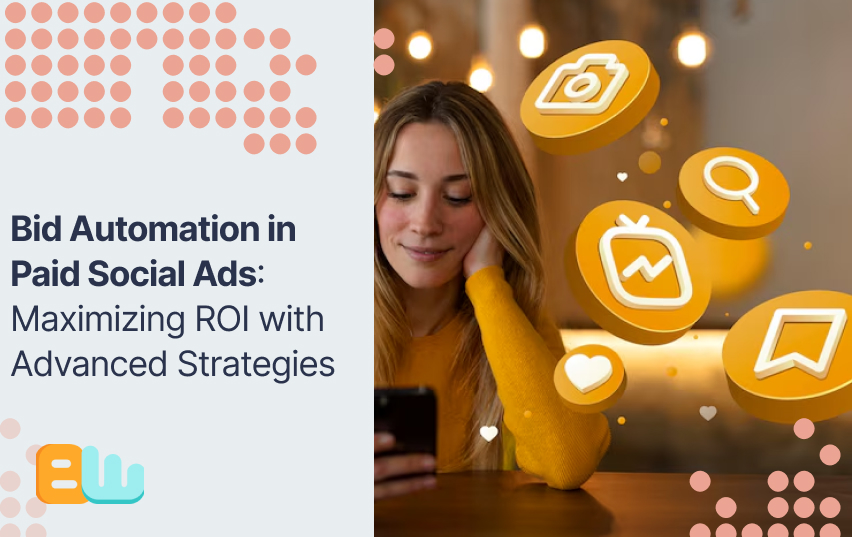
Do you still modify your social media ad campaigns’ bids manually? You may be wasting too much time on everyday tasks and losing out on income. With the social media landscape growing increasingly competitive, bid automation has gone from a optional feature to an important component of effective paid social strategy.
Today’s marketers should work smarter, not harder. Bid automation systems enable you accomplish exactly that by optimizing your ad spend based on real-time data and performance metrics, usually providing better results than manual bidding.
In this post, you’ll find out how automated bidding works across key social networks, ways to use it efficiently, and how to analyze its influence on your marketing goals.
Introduction to Bid Automation for Social Advertising
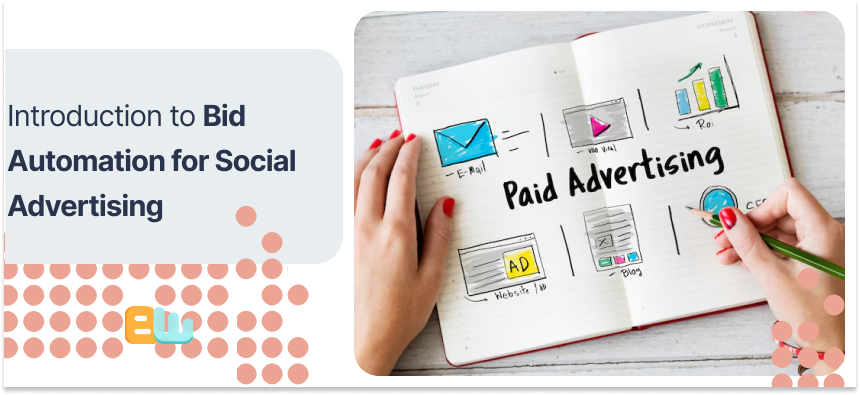
By using machine learning and algorithms, bid automation modifies your ad bids in real time according to the possibility of reaching your campaign goals. Automation technologies evaluate several signals to identify the best bid for each auction, eliminating the need to manually set fixed bids.
Why is this important? Manual optimization is nearly impossible due to the billions of ad auctions that social media networks distribute every day. Because automated bidding makes tiny adjustments that human marketers just cannot recreate at scale, it gives you a competitive advantage.
Recent industry data indicates that, when compared to manual bidding, advertisers who use automated bidding strategies see an average improvement in cost per acquisition of 20–30%. That’s a significant advantage in today’s competitive landscape.
The current state of bid automation varies across platforms. Facebook offers advanced automation through Campaign Budget Optimization and value-based bidding, while LinkedIn and TikTok have developed their own objective-based automated solutions. What unites them all is the shift toward letting algorithms handle bidding complexities while marketers focus on strategy.
Understanding the Fundamentals of Social Ad Bidding
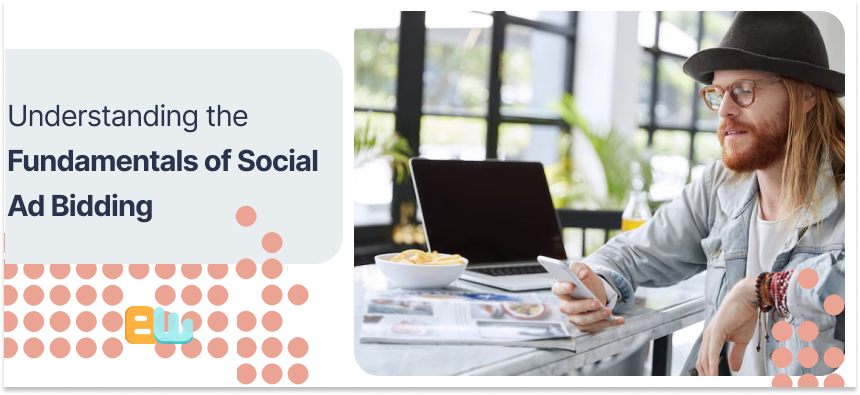
Having a solid understanding of the fundamentals of social ad auctions will help you make better decisions about your automation strategies.
How Social Ad Auctions Actually Work
Social platforms don’t simply award ad placements to the highest bidder. Instead, they use complex algorithms that consider three key factors:
1. Your bid amount
2. Estimated action rates (how likely users are to take your desired action)
3. Ad quality and relevance
These factors combine to create an “ad value” score.
5 Key Metrics That Drive Bidding Decisions
Successful bid automation relies on understanding which metrics actually matter. Here are the five most important ones:
1. Conversion Rate: How often users complete your desired action after seeing or clicking your ad.
2. Click-Through Rate (CTR): The percentage of people who click after seeing your ad, indicating its relevance.
3. Cost Per Acquisition (CPA): How much you spend to acquire each customer or conversion.
4. Return on Ad Spend (ROAS): The revenue generated for each dollar spent on advertising.
5. Lifetime Value (LTV): The total revenue a customer generates throughout their relationship with your business.
Comparing Manual vs. Automated Bidding Approaches
While manual bidding offers you complete control, it needs constant monitoring and adjustment, and it is best suited for small-scale campaigns or highly specialized markets where you can count on human judgment than algorithms.
Automated bidding excels at:
– Processing vast amounts of data quickly
– Making real-time bid adjustments
– Identifying patterns humans might miss
– Scaling efficiently across multiple campaigns
The trade-off with automation is reduced granular control. However, most advertisers find that the efficiency gains and performance improvements outweigh this limitation.
7 Powerful Bid Automation Strategies for Social Platforms
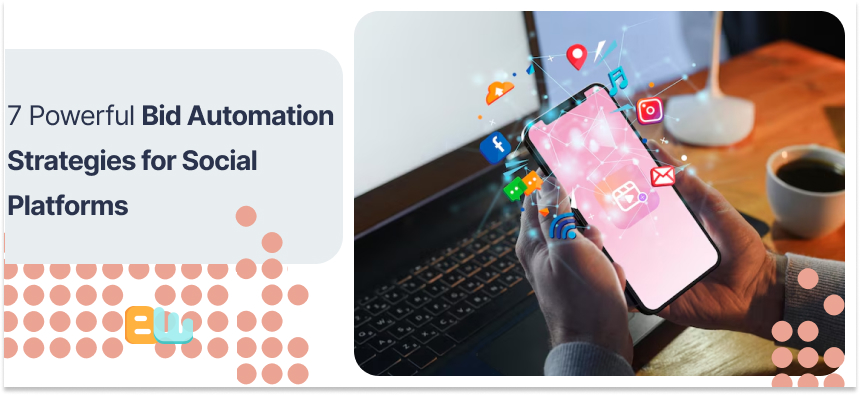
Now that you have a clear understanding of the basics, let’s look at specific strategies to maximize your bid automation results.
Goal-Based Bidding: Aligning Campaigns with Business Objectives
First, clearly define what success looks like for your company: are you concentrating on increasing sales, lead generation, brand awareness, or app installs?
Each platform offers automation options designed for specific goals:
– For awareness, use reach or impression-based bidding
– For engagement, optimize for clicks or video views
– For conversions, target specific actions like purchases or form completions
You have to resonate your business goals with your bidding strategy. For instance, optimizing for clicks alone won’t always leads to the best results if your goal is to drive in-store visits.
Audience-Specific Bid Adjustments for Higher Conversion
Not all audience segments perform equally. Automated bidding allows you to allocate more budget to high-performing segments without manually adjusting each one.
Set up your automation to bid more aggressively for:
– Previous website visitors
– Email subscribers
– Similar audiences based on your best customers
– High-value demographic groups
Dayparting: Optimizing Bids Around Peak Performance Times
Because user behavior changes throughout the day and week, smart bid automation uses dayparting to adjust bids based on when your audience is most likely to convert.
For example, an e-commerce site may perform better on weekends and evenings, while a B2B company may see higher conversion rates during business hours.
Rather than manually scheduling ads, let automation, raise bids during high-performing times and lower them during low-performing times to ensure you’re conservative when ROI would be lower and competitive when it matters most.
Device-Based Bid Automation for Multi-Platform Success
Mobile, desktop, and tablet users often behave differently and have varying conversion values. Bid automation can recognize these patterns and adjust accordingly.
For instance, your automation would automatically dedicate a larger portion of your budget to desktop placements if your data indicates that desktop users complete transactions at a rate that is 30% greater than that of mobile users.
This does not imply disregarding mobile; rather, it means evaluating all devices equally and allowing the system to choose the best bid for each one based on performance statistics.
Budget Pacing: Ensuring Consistent Ad Delivery
In addition to optimizing bids, efficient bid automation guarantees that your budget is distributed equitably over the course of your campaign.
If you don’t pace, you risk using up your money early in a day or month and losing out on later important impressions. Automated budget pacing adjusts your bids throughout the day to maintain visibility.
Most platforms offer two pacing options:
– Standard pacing (even delivery throughout the period)
– Accelerated pacing (faster delivery when opportunities arise)
Your campaign’s objectives will determine which option is best. For time-sensitive promotions, rapid pacing could be recommended, whereas ongoing brand campaigns benefit from regular pacing.
Competitive Landscape Adaptation Through Dynamic Bidding
The competitive environment changes constantly. During peak shopping seasons or industry events, competition intensifies, requiring higher bids to maintain visibility.
Dynamic bidding automatically adjusts to these competitive shifts. When competitors increase their bids, the system responds accordingly to maintain your desired position.
This prevents the common problem of previously successful campaigns suddenly underperforming due to competitive changes. The algorithm constantly recalibrates based on auction dynamics that would be impossible to track manually.
Seasonal Trend Optimization for Timely Campaigns
Consumer behavior vary with seasons, holidays, and events. Successful bid automation understands these changes and adjusts according to circumstances.
For instance, January is usually when fitness product conversion rates peak. Automation technologies can identify the higher conversion rates during this time and raise bids to take advantage of the greater potential rather than manually raising bids.
This seasonal modifications ensures that your campaigns stay optimized no matter what happens, and it works for both predictable events (like Black Friday) and unexpected trends.
Platform-Specific Bid Automation Techniques
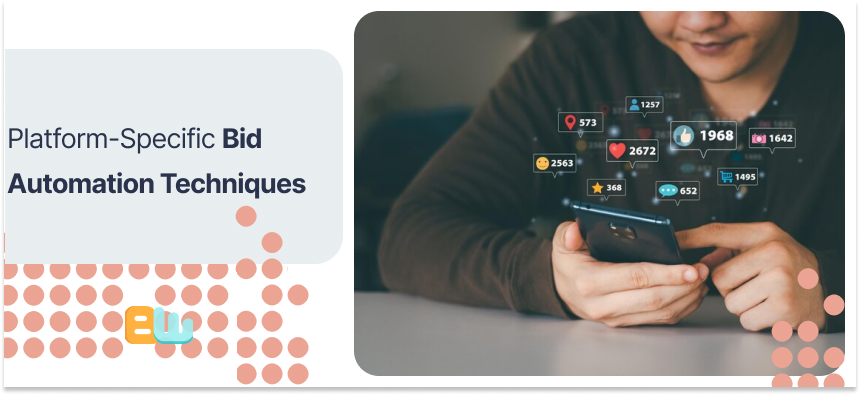
Each social platform has developed unique bidding systems. Understanding platform-specific features helps you maximize results across your entire social media mix.
Facebook’s Power 5 and Automated Bid Strategies
Facebook’s “Power 5” represents their core automation recommendations, with automated bidding as a central component. The platform offers several automation options:
– Lowest Cost: Maximizes results while spending your entire budget
– Cost Cap: Sets a maximum cost per result you’re willing to pay
– Bid Cap: Defines the maximum bid for each auction
– Target Cost: Aims for a consistent cost per result around your target
For most advertisers, Lowest Cost with Campaign Budget Optimization (CBO) provides the best balance of performance and control. CBO automatically distributes your budget across ad sets to favor those with the best performance.
One e-commerce client switched from manually managed ad sets to CBO with automated bidding and saw a 24% reduction in cost per purchase while increasing overall sales volume.
LinkedIn’s Objective-Based Advertising Approach
LinkedIn’s bid automation focuses on objective-based advertising with options tailored to B2B marketing goals:
– Maximum Delivery: Similar to Facebook’s Lowest Cost, maximizing results within your budget
– Target Cost: Aiming for a specific cost per result
– Manual Bidding: For those who want greater control
How Does TikTok’s Smart Bidding Transform Campaigns?
TikTok, Smart Bidding options include as below:
– Bid Cap: Setting your highest bid while optimizing for lowest cost
– Cost Cap: Targeting an average cost per result
– Lowest Cost: Maximizing results within your budget
Because TikTok’s algorithm is so good at identifying individuals who are most likely to interact with your content, marketers aiming to reach younger audiences can benefit greatly from their automatic bidding.
In order to give enough data for optimization, the platform advises starting with Lowest Cost bidding and achieving at least 50 conversions each week.
Twitter’s Bid Automation Tools for Engagement
Twitter provides options for automated bidding that are focused on the real-time engagement strengths of their platform:
– Automatic Bid: Optimizes for maximum results within budget
– Target Cost: Aims for a specific cost per result
– Maximum Bid: Sets an upper limit on what you’ll pay
Pinterest’s Automated Bidding for Visual Discovery
Pinterest’s visual discovery nature influences its bid automation approach:
– Automatic Bidding: Optimizes for maximum results
– Maximum Bid Strategy: Sets an upper limit while seeking efficiency
– Custom Bidding: For specific target costs
Pinterest’s automation works exceptionally well for visual products and longer consideration cycles, as the platform can track how users discover and save ideas over time before making purchase decisions.
Setting Up Your First Automated Bidding Campaign
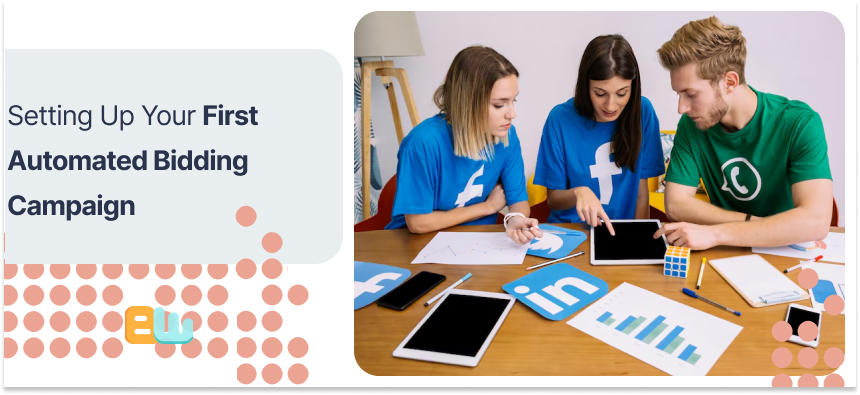
Let’s talk about how to use automated bidding effectively now that you understand the strategies and platform-specific techniques.
Selecting the Right KPIs for Your Bid Strategy
The most important step is selecting the right key performance indicators (KPIs) that match your business goals. Common options include:
– Conversions (purchases, sign-ups, downloads)
– Engagement (clicks, video views, interactions)
– Reach and awareness metrics
Your choice will determine which automation option is most appropriate. For example, if leads are your priority, optimize for form completions rather than clicks.
Be specific about the actions that truly matter to your business. If not all conversions are equal, consider value-based bidding that optimizes toward your highest-value outcomes.
Creating Effective Campaign Parameters for Automation
For automation to work effectively, you need to establish the right campaign foundation:
1. Define clear conversion events: Ensure proper tracking of the actions you want to optimize for.
2. Set realistic targets: Aggressive targets can limit delivery, while too-loose targets waste budget.
3. Provide sufficient budget: Automation needs room to test and learn—typically at least 5x your target cost per result.
4. Allow adequate learning time: Most platforms need 3-7 days and 50+ conversions before optimization becomes effective.
5. Minimize campaign changes: Frequent adjustments reset the learning phase, delaying optimization.
By establishing these parameters correctly, you give the automation systems the best chance to succeed.
Testing and Validation: Is Your Automation Working?
Once your automated campaigns are running, you need to validate their performance:
1. Compare pre-automation and post-automation results using the same metrics
2. Look for improvements in your primary KPI (like lower CPA or higher ROAS)
3. Monitor secondary metrics to ensure optimization isn’t coming at their expense
4. Check if performance improves over time as the algorithm collects more data
Remember that the early learning phase often shows fluctuating results. Give the system time before making judgment calls on effectiveness.
Troubleshooting Common Bid Automation Problems
If your automated campaigns aren’t working as planned, look for these common problems:
– Insufficient conversion data: The algorithm needs enough data points to optimize effectively
– Conflicting optimization goals: Trying to optimize for too many objectives simultaneously
– Restrictive targeting: Limiting your audience too narrowly prevents the algorithm from finding opportunities
– Unrealistic target costs: Setting targets too low can severely restrict delivery
– Poor creative performance: Even perfect bidding can’t overcome weak ad creative
Address these issues methodically, and in most cases, performance will improve without returning to manual bidding.
Advanced Data Integration for Smarter Bidding
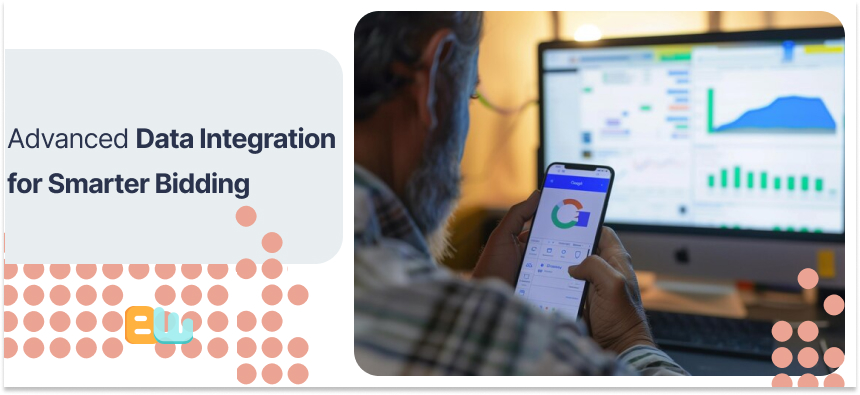
To advance your bid automation, use more data sources that offer deeper insights into customer value and behavior.
Leveraging First-Party Data to Enhance Bid Decisions
First-party data, or information you get directly from your customers, can significantly improve bidding performance when fed into automation systems.
Create Custom Audiences based on customer lists, website behavior data, and app activity to help the automation identify high-value prospects more efficiently.
For example, by uploading purchase history data, you can help Facebook’s value optimization identify users similar to your best customers, automatically bidding higher for these valuable prospects.
CRM Integration: Connecting Sales Data to Ad Bidding
Connecting your CRM to your advertising platforms creates a feedback loop that improves bid optimization:
1. Ad interactions lead to website visits
2. Leads enter your CRM
3. Leads convert to customers
4. This conversion data feeds back into ad platforms
5. Bidding algorithms learn which leads are most valuable
This closed-loop reporting helps the automation understand the true value of different customer types, improving bid decisions for future prospects.
Several clients have seen 30-40% improvements in ROAS after implementing proper CRM integration with their social advertising.
How AI and Machine Learning Transform Bid Strategies
The latest bid automation systems use advanced AI to identify patterns human marketers might miss:
– Recognizing complex combinations of user attributes that predict conversion
– Identifying optimal timing patterns beyond simple dayparting
– Adjusting to subtle market changes in real-time
– Learning from cross-campaign data to improve performance
These capabilities allow modern bid automation to outperform even the most diligent manual bidding approaches in most cases.
Cross-Platform Data Synchronization for Unified Bidding
For maximum effectiveness, synchronize data across all your marketing platforms:
1. Share conversion data between platforms (when privacy rules allow)
2. Use consistent tracking parameters to measure cross-platform customer journeys
3. Implement cross-platform attribution to understand how channels work together
4. Feed this unified data back into your bidding systems
This approach prevents different platforms from competing against each other and helps automation tools understand the customer’s entire journey.
Measuring Success: Bid Automation Performance Metrics
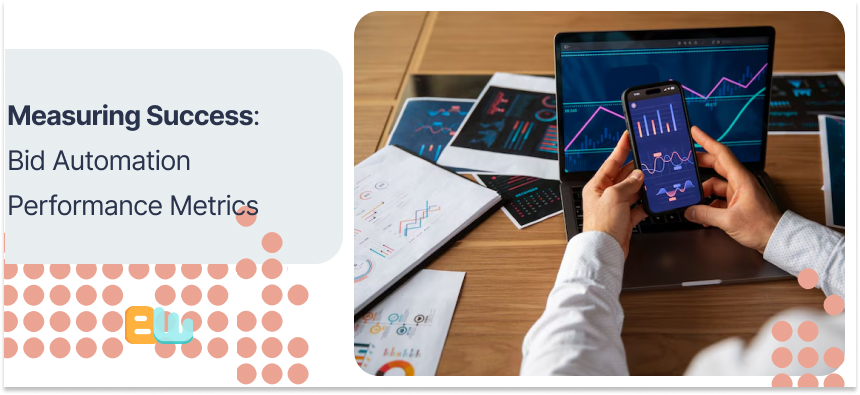
How do you know if your bid automation is truly successful? Look beyond the obvious metrics to get a complete picture.
Beyond ROAS: Comprehensive Metrics for Bid Evaluation
While ROAS and CPA are important, consider these additional metrics when evaluating automated bidding:
– Conversion volume: Are you getting more total conversions?
– Impression share: What percentage of available auctions are you winning?
– Revenue per impression: Are you making more efficient use of your visibility?
– New customer acquisition rate: Are you bringing in new business or just retargeting existing customers?
– Profit margin: Are you accounting for product costs in your evaluation?
These broader metrics provide a more complete picture of performance than simple efficiency metrics alone.
A/B Testing Framework for Bid Strategy Comparison
To truly validate your automated bidding, implement structured A/B tests:
1. Run identical campaigns with different bid strategies simultaneously
2. Ensure equal budgets and targeting
3. Maintain the test for at least 2-4 weeks (or until statistical significance)
4. Compare not just efficiency metrics but total business impact
This scientific approach removes doubt about whether automation is truly outperforming manual methods or other automation options.
Incrementality Testing: Determining True Campaign Impact
The ultimate test for any bidding strategy is incrementality: how much additional business did it generate that wouldn’t have occurred otherwise?
Test this by:
– Running geo-split tests (increased spending in test markets)
– Implementing holdout groups (excluding some qualified users from targeting)
– Measuring lift against control groups
These methods help distinguish between correlation and causation in your campaign results, validating that your bid automation is truly driving business growth.
Long-Term Performance Tracking for Bid Strategies
Automation performance should improve over time as algorithms collect more data. Track these long-term trends:
– Monthly performance compared to previous periods
– Seasonal efficiency variations
– Learning curve improvements after campaign changes
– Adaptation to market changes and competitive shifts
Looking at these long-term patterns helps you distinguish between temporary fluctuations and true performance trends.
Future of Bid Automation in Social Advertising
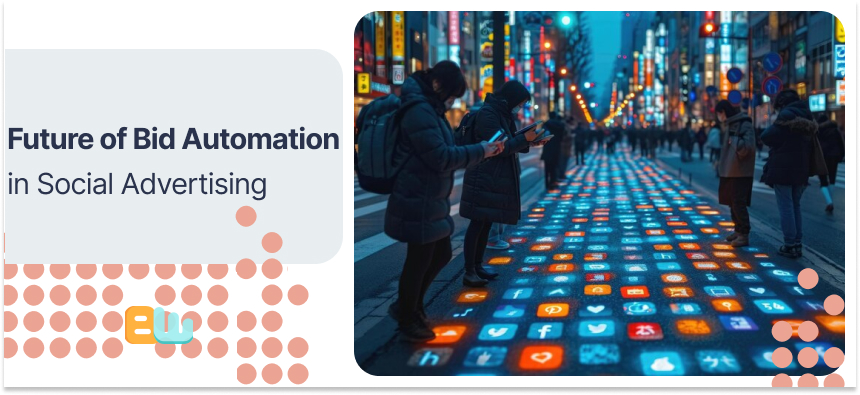
The field of automated bidding is still developing quickly. Here are some things to be aware of.
How Will Privacy Changes Impact Automated Bidding?
Recent privacy changes—including iOS updates and cookie deprecation—have significant implications for bid automation:
– Reduced user-level tracking requires more modeling and aggregated data
– First-party data becomes increasingly valuable as third-party data diminishes
– Platforms are developing privacy-friendly machine learning approaches
– Conversion modeling replaces direct measurement in more cases
Prepare for these changes by strengthening your first-party data collection and exploring platforms’ privacy-enhanced measurement solutions.
Emerging Technologies Reshaping Bid Automation
Several emerging technologies will transform bid automation in the coming years:
– Predictive analytics that forecast user behavior before actions occur
– Cross-platform AI that understands the entire customer journey
– Natural language processing that optimizes bids based on creative content
– Automated creative testing integrated with bidding decisions
These technologies will further reduce the need for manual optimization while improving campaign performance.
Preparing Your Strategy for Next-Generation Bidding Tools
To stay ahead of these changes:
1. Develop strong first-party data strategies
2. Experiment with emerging automation options as they become available
3. Focus on creative excellence to complement automated bidding
4. Build skills in data analysis and strategy rather than manual implementation
5. Test new platforms early to gain experience with their automation approaches
Instead of playing catch-up, this forward-thinking strategy guarantees that you will take advantage of new capabilities as they become available.
Conclusion: Building Your Bid Automation Roadmap
In social advertising, bid automation has evolved from an optional convenience to a competitive must. When done right, it saves time, boosts productivity, and frees you up to concentrate on strategic choices rather than manual modifications.
Start your automation journey with these steps:
1. Audit your current bidding approach and identify opportunities for automation
2. Select one platform to begin with, preferably where you have the most data
3. Implement proper tracking and conversion measurement
4. Choose the appropriate automation strategy based on your business objectives
5. Allow sufficient learning time and budget
6. Measure results comprehensively, beyond simple efficiency metrics
7. Gradually expand to additional campaigns and platforms
Keep in mind that strategic thought and automation function best together. The most effective advertisers concentrate their human skills on creative, audience strategy, and business alignment while using automation to manage the complications of bid management.
By accepting bid automation while keeping strategic supervision, you’ll position your social advertising for maximum impact in today’s competitive landscape.
